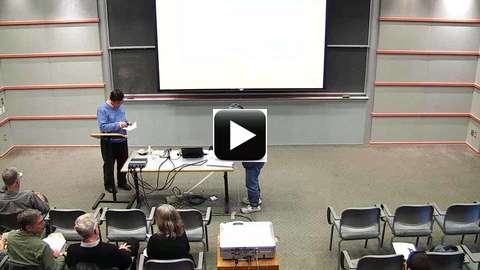Fundamental nanoscale studies show that there are adhesive molecules in
abalone shell, bone and other materials that use the nanoscale mechanism
of sacrificial bonds and hidden length to dissipate energy. These
molecules are present in the gel matrix that binds together the
mineralized collagen fibrils of bone. Bone fracture begins with the
separation of the mineralized collagen fibrils at nanometer length
scales.
New instruments can now test how well bone resists this nanoscale
separation of mineralized collagen fibrils . even in living patients!
The results of these tests distinguish between the bone of patients with
and without fractures. Thus, these instruments have the potential to
diagnose bone fragility and to guide the development of therapies for
decreasing bone fragility.
 Other video options
Other video options
To begin viewing slides, click on the first slide below. (Or, view as pdf.)
![[01]](tn/01.jpg)
![[02]](tn/02.jpg)
![[03]](tn/03.jpg)
![[04]](tn/04.jpg)
![[05]](tn/05.jpg)
![[06]](tn/06.jpg)
![[07]](tn/07.jpg)
![[08]](tn/08.jpg)
![[09]](tn/09.jpg)
![[10]](tn/10.jpg)
![[11]](tn/11.jpg)
![[12]](tn/12.jpg)
![[13]](tn/13.jpg)
![[14]](tn/14.jpg)
![[15]](tn/15.jpg)
![[16]](tn/16.jpg)
![[17]](tn/17.jpg)
![[18]](tn/18.jpg)
![[19]](tn/19.jpg)
![[20]](tn/20.jpg)
![[21]](tn/21.jpg)
![[22]](tn/22.jpg)
![[23]](tn/23.jpg)
![[24]](tn/24.jpg)
![[25]](tn/25.jpg)
![[26]](tn/26.jpg)
![[27]](tn/27.jpg)
![[28]](tn/28.jpg)
![[29]](tn/29.jpg)
![[30]](tn/30.jpg)
![[31]](tn/31.jpg)
![[32]](tn/32.jpg)
![[33]](tn/33.jpg)
![[34]](tn/34.jpg)
![[35]](tn/35.jpg)
![[36]](tn/36.jpg)
![[37]](tn/37.jpg)
![[38]](tn/38.jpg)
![[39]](tn/39.jpg)
![[40]](tn/40.jpg)
![[41]](tn/41.jpg)
![[42]](tn/42.jpg)
![[43]](tn/43.jpg)
![[44]](tn/44.jpg)
![[45]](tn/45.jpg)
![[46]](tn/46.jpg)
![[47]](tn/47.jpg)